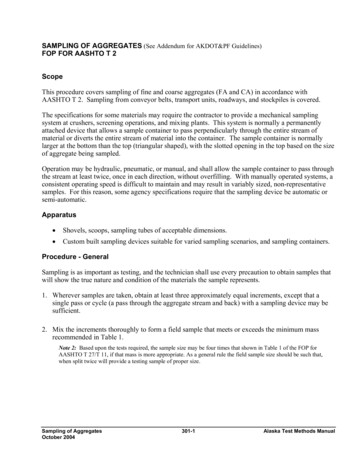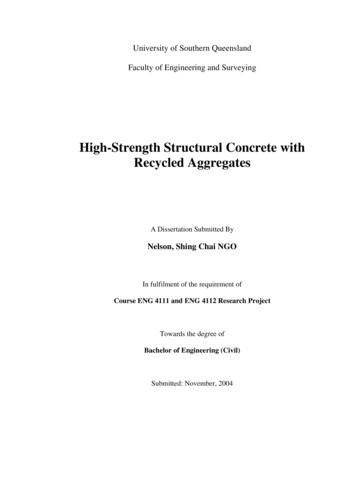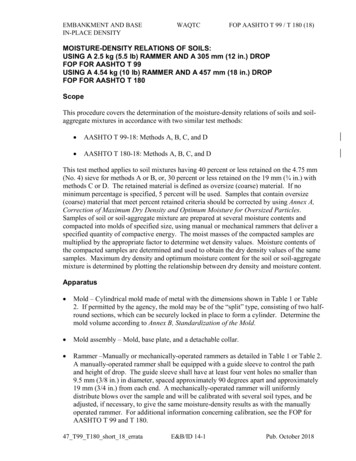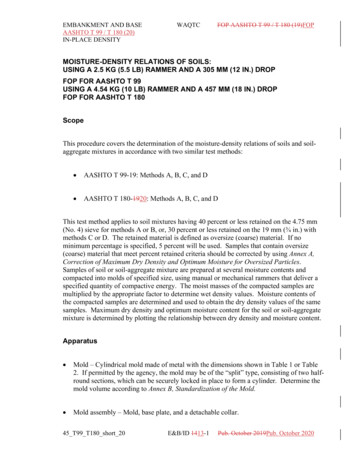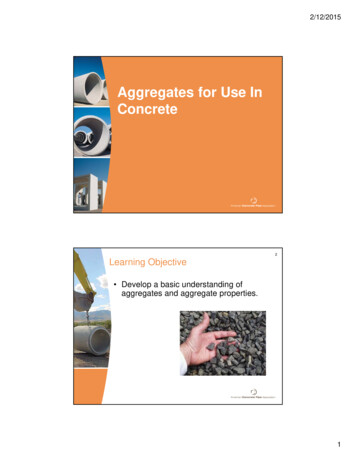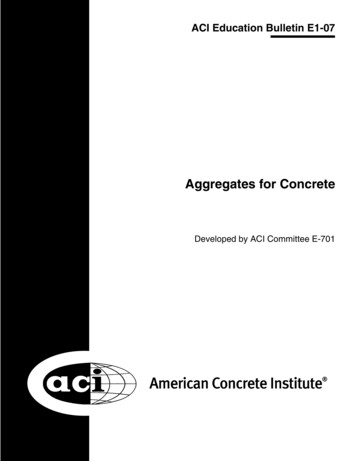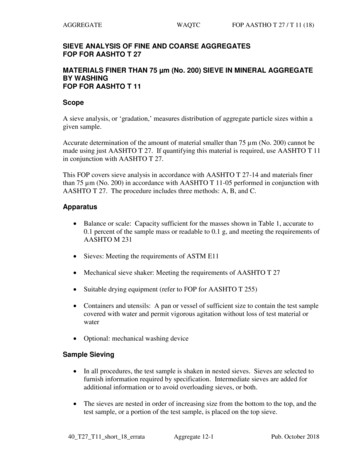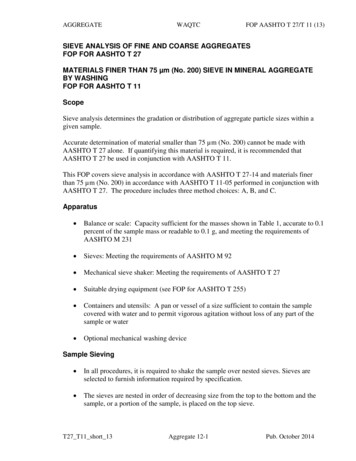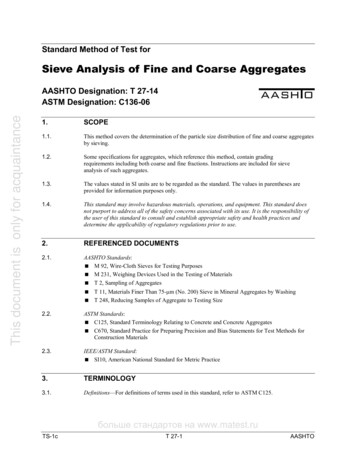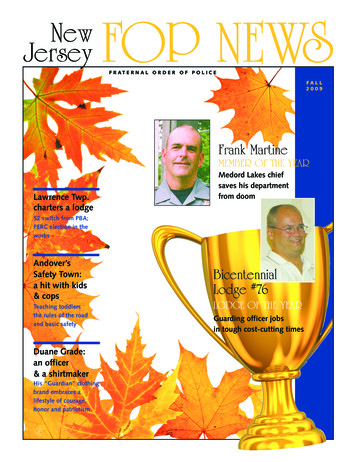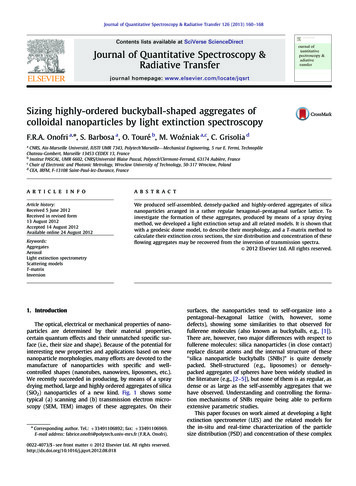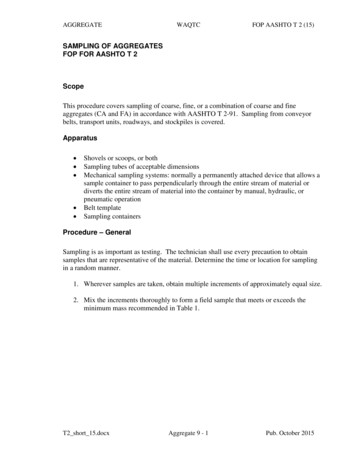
Transcription
AGGREGATEWAQTCFOP AASHTO T 2 (15)SAMPLING OF AGGREGATESFOP FOR AASHTO T 2ScopeThis procedure covers sampling of coarse, fine, or a combination of coarse and fineaggregates (CA and FA) in accordance with AASHTO T 2-91. Sampling from conveyorbelts, transport units, roadways, and stockpiles is covered.Apparatus Shovels or scoops, or bothSampling tubes of acceptable dimensionsMechanical sampling systems: normally a permanently attached device that allows asample container to pass perpendicularly through the entire stream of material ordiverts the entire stream of material into the container by manual, hydraulic, orpneumatic operationBelt templateSampling containersProcedure – GeneralSampling is as important as testing. The technician shall use every precaution to obtainsamples that are representative of the material. Determine the time or location for samplingin a random manner.1. Wherever samples are taken, obtain multiple increments of approximately equal size.2. Mix the increments thoroughly to form a field sample that meets or exceeds theminimum mass recommended in Table 1.T2 short 15.docxAggregate 9 - 1Pub. October 2015
AGGREGATEWAQTCFOP AASHTO T 2 (15)TABLE 1Recommended Sample SizesNominal MaximumMinimum MassSize* mm (in.)g (lb)2.36 (No. 8)10,000 (25)4.75 (No. 4)10,000 (25)9.5 (3/8)10,000 (25)12.5 (1/2)15,000 (35)19.0 (3/4)25,000 (55)25.0 (1)50,000 (110)37.5 (1 1/2)75,000 (165)50 (2)100,000 (220)63 (2 1/2)125,000 (275)75 (3)150,000 (330)90 (3 1/2)175,000 (385)* One sieve larger than the first sieve to retain more than 10 percent of the material using an agency specifiedset of sieves based on cumulative percent retained. Where large gaps in specification sieves exist, intermediatesieve(s) may be inserted to determine nominal maximum size. Maximum size is one size larger than nominalmaximum size.Note 1: Sample size is based upon the test(s) required. As a general rule the field sample size should be suchthat, when split twice will provide a testing sample of proper size. For example the sample size maybe four times that shown in Table 2 of the FOP for AASHTO T 27/T 11, if that mass is moreappropriate.Procedure – Specific SituationsConveyor BeltsAvoid sampling at the beginning or end of the aggregate run due to the potential forsegregation. Be careful when sampling in the rain. Make sure to capture fines that maystick to the belt or that the rain tends to wash away.Method A (From the Belt):1. Stop the belt.2. Set the sampling template in place on the belt, avoiding intrusion by adjacentmaterial.3. Remove the material from inside the template, including all fines.4. Obtain a minimum of 3 approximately equal increments.5. Combine the increments to form a single sample.T2 short 15.docxAggregate 9 - 2Pub. October 2015
AGGREGATEWAQTCFOP AASHTO T 2 (15)Method B (From the Belt Discharge):1. Pass a sampling device through the full stream of the material as it runs off the end ofthe conveyor belt. The sampling device may be manually, semi-automatic orautomatically powered.2. The sampling device shall pass through the stream at least twice, once in eachdirection, without overfilling while maintaining a constant speed during the samplingprocess.3. When emptying the sampling device into the container, include all fines.4. Combine the increments to form a single sample.Transport Units1. Visually divide the unit into four quadrants.2. Identify one sampling location in each quadrant.3. Dig down and remove approximately 0.3 m (1 ft.) of material to avoid surfacesegregation. Obtain each increment from below this level.4. Combine the increments to form a single sample.RoadwaysMethod A (Berm or Windrow):1. Obtain sample prior to spreading.2. Take the increments from a minimum of three random locations along the fullyformed windrow or berm. Do not take the increments from the beginning or the endof the windrow or berm.3. Obtain full cross-section samples of approximately equal size at each location. Takecare to exclude the underlying material.4. Combine the increments to form a single sample.Note 2: Obtaining samples from berms or windrows may yield extra-large samples and may not be thepreferred sampling location.Method B (In-Place):1. Obtain sample after spreading and prior to compacting.T2 short 15.docxAggregate 9 - 3Pub. October 2015
AGGREGATEWAQTCFOP AASHTO T 2 (15)2. Take the increments from three random locations.3. Obtain full-depth increments of approximately equal size from each location. Takecare to exclude the underlying material.4. Combine the increments to form a single sample.StockpilesMethod A – Coarse, Fine, or a Combination of Coarse and Fine Aggregates:1. Create, with a loader if one is available, horizontal surfaces with vertical faces in thetop, middle, and bottom third of the stockpile. When no equipment is available ashovel may be used to create the horizontal surfaces with vertical faces.2. Prevent continued sloughing by shoving a flat board in against the vertical face.Sloughed material will be discarded to create the horizontal surface.3. Obtain sample from the horizontal surface as close to the intersection as possible ofthe horizontal and vertical faces.4. Obtain at least one increment of equal size from each of the top, middle, and bottomthirds of the pile.5. Combine the increments to form a single sample.Method B – Fine Aggregate (Alternate Tube Method):1. Remove the outer layer that may have become segregated.2. Using a sampling tube, obtain one increment of equal size from a minimum of fiverandom locations on the pile.3. Combine the increments to form a single sample.Note 3: Obtaining samples at stockpiles should be avoided whenever possible due to problems involved inobtaining a representative gradation of material.T2 short 15.docxAggregate 9 - 4Pub. October 2015
AGGREGATEWAQTCFOP AASHTO T 2 (15)Report On forms approved by the agency Date Time Sample ID Location Quantity representedT2 short 15.docxAggregate 9 - 5Pub. October 2015
Standard Method of Test forBulk Density (“Unit Weight”)and Voids in AggregateAASHTO Designation: T 19M/T 19-14ASTM Designation: C 29/C 29M-09American Association of State Highway and Transportation Officials444 North Capitol Street N.W., Suite 249Washington, D.C. 20001
Standard Method of Test forBulk Density (“Unit Weight”)and Voids in AggregateAASHTO Designation: T 19M/T 19-14ASTM Designation: C 29/C 29M-091.SCOPE1.1.This test method covers the determination of bulk density (“unit weight”) of aggregate in acompacted or loose condition, and calculated voids between particles in fine, coarse, or mixedaggregates based on the same determination. This test method is applicable to aggregates notexceeding 125 mm [5 in.] in nominal maximum size.Note 1—Unit weight is the traditional terminology used to describe the property determinedby this test method, which is weight per unit volume (more correctly, mass per unit volumeor density).1.2.The values stated in either inch-pound units or acceptable metric units are to be regardedseparately as standard, as appropriate for a specification with which this test method is used.An exception is with regard to sieve sizes and nominal size of aggregate, in which the metricvalues are the standard as stated in ASTM E 11. Within the text, inch-pound units are shown inbrackets. The values stated in each system may not be exact equivalents; therefore, eachsystem must be used independently of the other, without combining values in any way.1.3.This standard may involve hazardous materials, operations, and equipment. This standard doesnot purport to address all of the safety problems associated with its use. It is the responsibility ofthe user of this standard to establish appropriate safety and health practices and determine theapplicability of regulatory limitations prior to use.2.REFERENCED DOCUMENTS2.1.AASHTO Standards: M 92, Wire-Cloth Sieves for Testing Purposes M 231, Weighing Devices Used in the Testing of Materials T 2, Sampling of Aggregates T 84, Specific Gravity and Absorption of Fine Aggregate T 85, Specific Gravity and Absorption of Coarse Aggregate T 121M/T 121, Density (Unit Weight), Yield, and Air Content (Gravimetric) of Concrete T 248, Reducing Samples of Aggregate to Testing Size2.2.ASTM Standards: C 29/C 29M, Standard Test Method for Bulk Density (“Unit Weight”) and Voids inAggregate C 125, Standard Terminology Relating to Concrete and Concrete AggregatesTS-1cT 19M/T 19-1AASHTO
C 670, Standard Practice for Preparing Precision and Bias Statements for Test Methods forConstruction Materials D 123, Standard Terminology Relating to Textiles E 11, Standard Specification for Woven Wire Test Sieve Cloth and Test Sieves3.TERMINOLOGY3.1.definitions—definitions are in accordance with ASTM C 125 unless otherwise indicated.3.1.1.bulk density, n—of aggregate, the mass of a unit volume of bulk aggregate material, in which thevolume includes the volume of the individual particles and the volume of the voids between theparticles. Expressed in kg/m3(lb/ft3).3.1.1.1.discussion—units of mass are the kilogram (kg), the pound (lb), or units derived from these. Massmay also be visualized as equivalent to inertia, or the resistance offered by a body to change ofmotion (acceleration). Masses are compared by weighing the bodies, which amounts to comparingthe forces of gravitation acting on them. ASTM D 123.3.1.2.unit weight, n—weight (mass) per unit volume. (Deprecated term—use preferred term “bulkdensity.”)3.1.2.1.discussion—the term weight means the force of gravity acting on the mass.3.1.3.weight, n—the force exerted on a body by gravity. (See also mass.)3.1.3.1.discussion—weight is equal to the mass of the body multiplied by the acceleration due to gravity.Weight may be expressed in absolute units (newtons, poundals) or in gravitational units (kgf, lbf),for example: on the surface of the earth, a body with a mass of 1 kg has a weight of 1 kgf(approximately 9.81 N), or a body with a mass of 1 lb has a weight of 1 lbf (approximately 4.45 Nor 32.2 poundals). Because weight is equal to mass times the acceleration due to gravity, theweight of a body will vary with the location where the weight is determined, while the mass of thebody remains constant. On the surface of the earth, the force of gravity imparts to a body that isfree to fall an acceleration of approximately 9.81 m/s2 [32.2 ft/s2]. ASTM D 123.3.2.Descriptions of Terms:3.2.1.voids, n—in unit volume of aggregate, the space between particles in an aggregate mass notoccupied by solid mineral matter.3.2.1.1.discussion—voids within particles, either permeable or impermeable, are not included in voids asdetermined by T 19M/T 19.4.SIGNIFICANCE AND USE4.1.This test method is often used to determine bulk density values that are necessary for use for manymethods of selecting proportions for concrete mixtures.4.2.The bulk density also may be used for determining mass/volume relationships for conversions inpurchase agreements. However, the relationship between degree of compaction of aggregates in ahauling unit or stockpile and that achieved in this method is unknown. Further, aggregates inhauling units and stockpiles usually contain absorbed and surface moisture (the latter affectingbulking), while this method determines the bulk density on a dry basis.TS-1cT 19M/T 19-2AASHTO
4.3.A procedure is included for computing the percentage of voids between the aggregate particlesbased on the bulk density determined by this method.5.APPARATUS5.1.Balance—The balance shall have sufficient capacity, be readable to 0.1 percent of the samplemass, or better, and conform to the requirements of M 231.5.2.Tamping Rod—A round, straight steel rod, 16 mm [5/8 in.] in diameter and approximately 600 mm[24 in.] in length, having one end rounded to a hemispherical tip of the same diameter as the rod.5.3.Measure—A cylindrical metal measure, preferably provided with handles. It shall be watertight,with the top and bottom true and even, and sufficiently rigid to retain its form under rough usage.The measure should have a height approximately equal to the diameter, but in no case shall theheight be less than 80 percent nor more than 150 percent of the diameter. The capacity of themeasure shall conform to the limits in Table 1 for the aggregate size to be tested. The thickness ofmetal in the measure shall be as described in Table 2. The top rim shall be smooth and planewithin 0.25 mm [0.01 in.] and shall be parallel to the bottom within 0.5 degrees (Note 2). Theinterior wall of the measure shall be a smooth and continuous surface.Table 1—Capacity of MeasuresNominalMaximumSize ofAggregatemmin.12.5a1/2Capacity of MeasureaL (m3)ft32.8 (0.0028)19.3 (0.0093)125.0137.511/214 (0.014)/10/31/275328 (0.028)1100470 (0.070)21/21255100 (0.100)31/2The indicated size of measure shall be used to test aggregatesof a nominal maximum size equal to or smaller than that listed.The actual volume of the measure shall be at least 95 percent ofthe nominal volume listed.Note 2—The top rim is satisfactorily plane if a 0.25 mm [0.01 in.] feeler gauge cannot be insertedbetween the rim and a piece of 6 mm [1/4 in.] or thicker plate glass laid over the measure. The topand bottom are satisfactorily parallel if the slope between pieces of plate glass in contact with thetop and bottom does not exceed 0.87 percent in any direction.5.3.1.If the measure also is to be used for testing for bulk density of freshly mixed concrete according toT 121M/T 121, the measure shall be made of steel or other suitable metal not readily subject toattack by cement. Reactive materials such as aluminum alloys are permitted, where as aconsequence of an initial reaction, a surface film is formed that protects the metal against furthercorrosion.5.3.2.Measures larger than nominal 28-L [1-ft3] capacity shall be made of steel for rigidity, or theminimum thicknesses of metal listed in Table 2 should be suitably increased.TS-1cT 19M/T 19-3AASHTO
Table 2—Requ
31.10.2013 · AGGREGATE WAQTC FOP AASHTO T 2 (15) T2_short_15.docx Aggregate 9 - 1 Pub. October 2015 SAMPLING OF AGGREGATES FOP FOR AASHTO T 2 . Scope . This procedure covers sampling of coarse, fine, or a combination of coarse and fine aggregates (CA and FA) in accordance with AASHTO T 2-91. Sampling from conveyor
